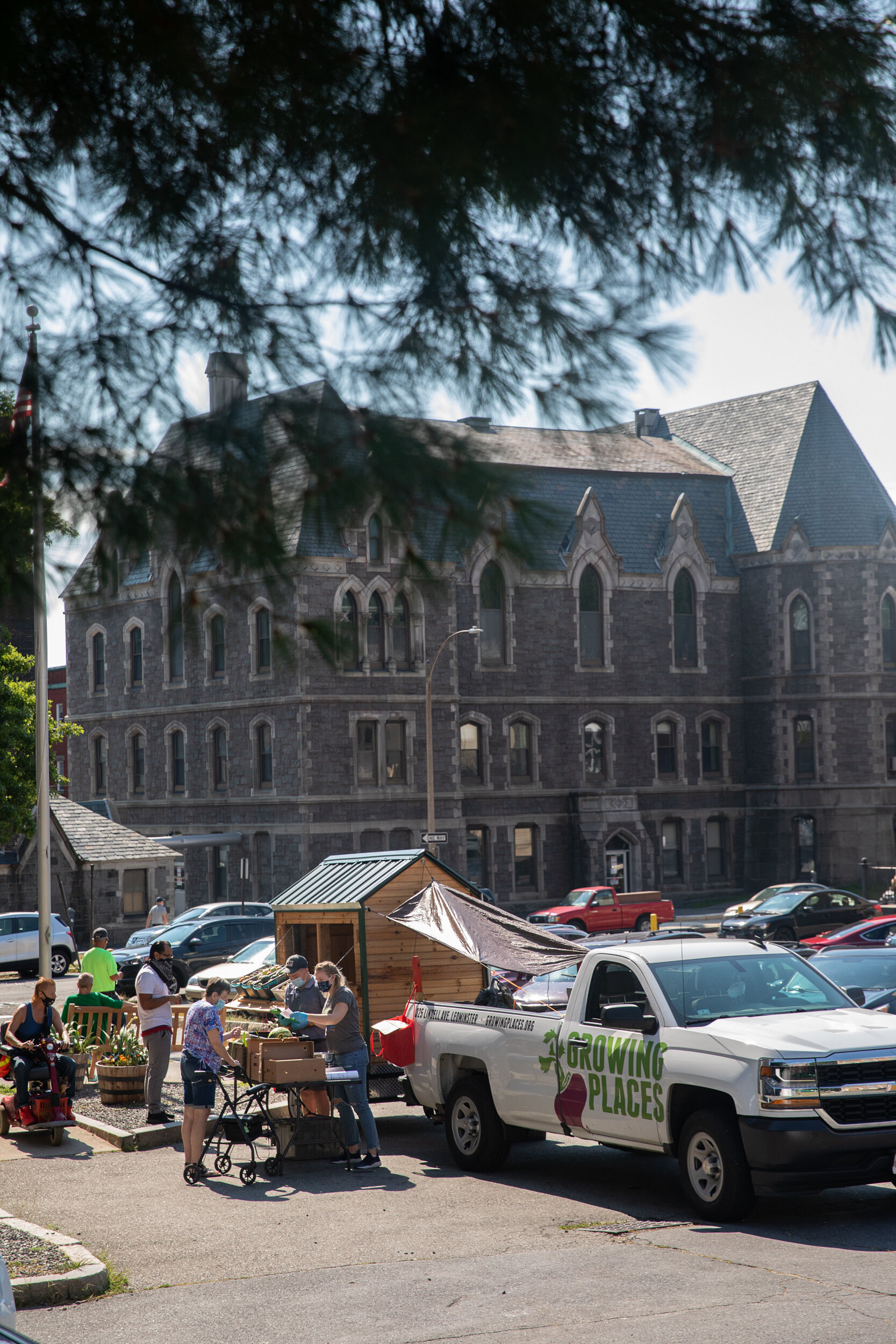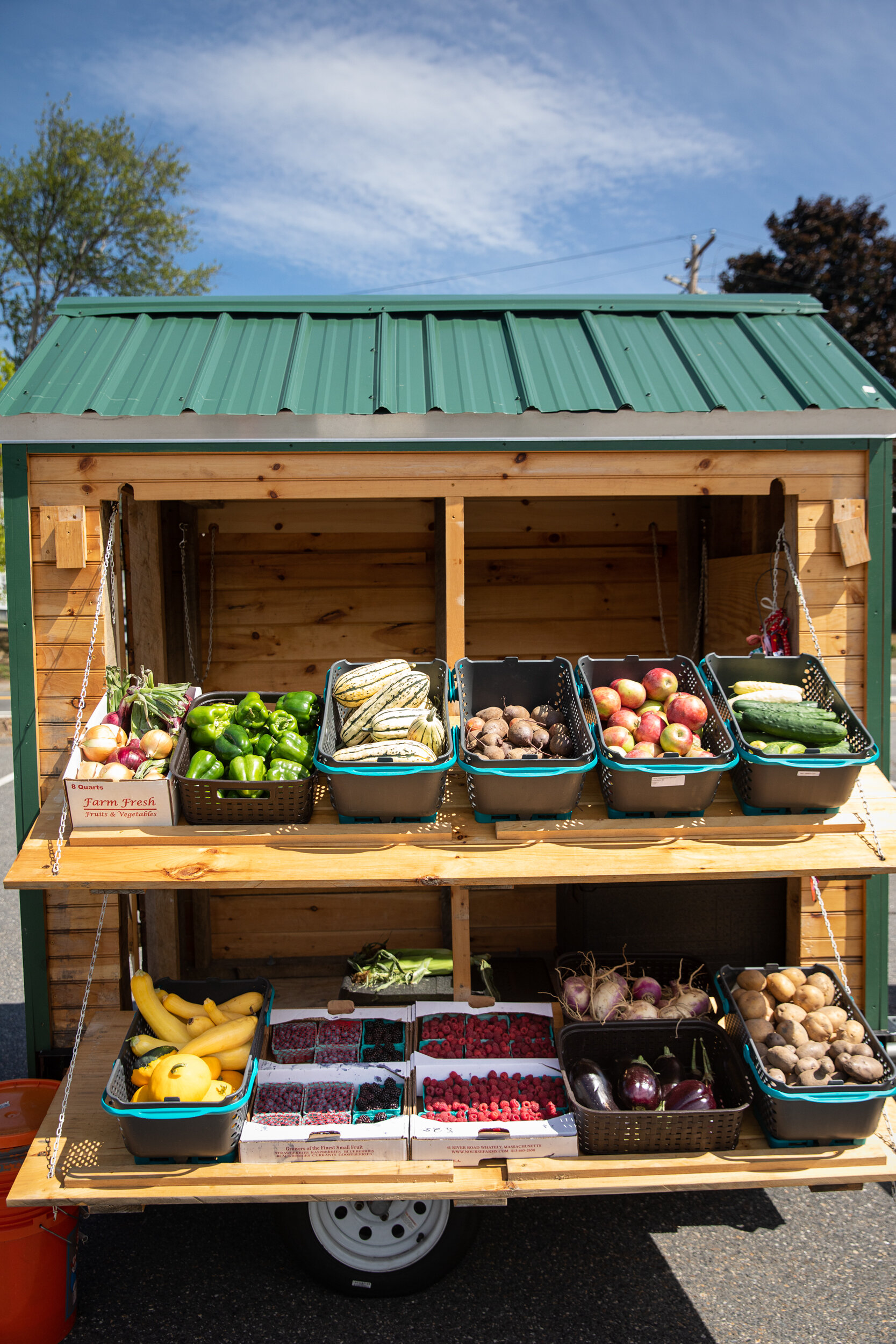Feeding Each Other: Growing Places Nourishes its Community in Numerous Ways
Photos by Little Outdoor Giants
When there’s produce to distribute and only so many hours in the day, Janet Edwards multitasks while sitting in the passenger seat of a pickup truck. As director of program development and education for Growing Places, she’s hauling its Mobile Market, filled to the brim with locally grown tomatoes, cucumbers and squash, to various locations in North Central Massachusetts.
Since 2001, when founders Kate Deyst and Cindy Buhner built their first five gardens, Growing Places has expanded in scope and size, creating more than 450 gardens and providing technical support to more than 1,500 low-income people in the region. This year, Executive Director Ayn Yeagle, as well as other coordinators, volunteers, sponsors and donors, haven’t let COVID-19 interfere with their mission of responding to community needs.
To fulfill its mission of providing equitable access to healthy food and environmental sustainability through education, collaboration and advocacy, the multifaceted nonprofit organizes school and community teaching gardens in Clinton, Fitchburg, Gardner, Winchendon and Leominster; manages farmers markets; stocks the Mobile Market with farm-fresh produce and delivers it throughout North Central MA; runs multiple hands-on youth programs; offers gardening education and even works with local restaurants to offer occasional to-go options available for purchase.
North Central MA is made up of 27 contiguous communities, including many rural areas defined by the U.S. Department of Agriculture (USDA) as low-income, low-access. According to the USDA, “‘Low-access’ means a significant number or share of the population in the tract had limited access to a food store (supermarket, supercenter or large grocery store)—i.e., they lived more than one mile from a food store in urban areas or more than 10 miles in rural areas.” Winchendon and Gardner, two towns in Worcester County, fall under these categories.
“When there is a small, rural community you just don’t have enough population to support a really large grocery store, so either you have to set the prices higher to support your overhead and your staff, or you just can’t go there because you don’t have a viable business,” says Edwards. “It’s really not the grocery store’s fault. It’s the business model, the population size and how our systems are set up.”
So with a small staff and the help of volunteers, Growing Places not only grows food but teaches people how to grow their own food. Currently they employ three full-time and four part-time staff members at their office in Leominster, but it would be impossible for them to accomplish everything they do if it weren’t for the help of volunteers. These folks organize the warehouse, package produce for donations and even work in the school and community gardens.
“They grow food to be donated, which helps keep our market sustainable, because not everyone can afford produce. Even though our prices are very reasonable and they’re competitive with local supermarkets, some people come to us and they still can’t afford it, so we subsidize, which helps some of that. Volunteers help grow, harvest and deliver—all of it,” says Edwards.
The community gardens are also available to residents of North Central MA who want or need a place where they can grow their own food. The organization offers gardening lessons each spring and fall; quality, inexpensive plant material; garden-to-table recipes and a community of local gardeners in addition to providing space to garden.
While the organization has traditionally managed farmers markets, the Mobile Market was created when they discovered that some farmers weren’t able to make ends meet because the markets didn’t have enough foot traffic. “We don’t want the people who are growing our food to be the people we are serving the same food to,” says Edwards. Produce is grown in the community gardens, then crates of it are driven directly to 16 locations each week, in the regions where it is needed the most. All forms of payment are accepted, including Supplemental Nutrition Assistance Program (SNAP) and Healthy Incentives Program (HIP), meaning fewer families will go hungry.
The Mobile Market was scheduled to go on the road in May, but because of COVID-19 it was launched in March instead, Edwards says. The need to get nutritious fruits and vegetables and hard-to-come-by pantry staples to food-insecure people during such uncertain times was strong.
In addition to improving food access to local residents, they teach youth about food. Teaching Gardens for Kids (TG4K) is one of Growing Places’ youth development programs, developed in response to what teachers and parents said about kids not knowing where their food came from.
“We had the community gardens and parents would come with their kids, but we didn’t really have a specific program just for youths at the time,” says Edwards. Kids can learn the importance of designing effective vegetable gardens while utilizing geometric formulas in this 10-week program, which teaches healthy eating, gardening and environmental sustainability.
A hydroponics gardening component has been integrated into the program for use in schools, Edward says, adding that kids really enjoy picking herbs, whether they love them or hate them, because they have such strong flavors. “They might recognize mint from their toothpaste, even though that’s not where you would normally think about it. It was a pivotal moment for a lot of kids when they got to see it for the first time as it grew, instead of in some other form.”
Another program, The Grow Your Own Way program, offers teens a safe place where they can completely unplug. Whether they are watering plants, pulling weeds, setting down mulch or admiring their winter squash, being outside in the fresh air gives them the space they need to not only learn about the plants they are tending to, but themselves.
When schools closed last spring because of the pandemic, the youth programs had to be canceled or adapted considerably. They delivered lettuce kits—including seeds, soil and containers—to families and children who wanted to grow lettuce, to be donated back to the Mobile Market or to food pantries. “We had about 70 families participate in this program,” says Edwards.
They hired older, more experienced kids to work with the Youth Development Coordinator to run Growing Places’ summer camps in Winchendon and Gardner, calling them “Root Leaders.” “One Root Leader was going through a lot of personal stress at home. Being part of the program was really his only access to a quiet, natural setting,” says Edwards. “It’s a novelty for teenagers, who are the busiest people on the planet, to unplug. Working in the garden allows them to do something that can go on their college applications and that benefits them and their community.”
For years Growing Places held an annual fundraiser (or “friend-raiser”) and invited as many people as possible, but with COVID, that wasn’t possible so instead, they “came up with an opportunity to engage the community, raise a little bit of awareness and raise some funds in a way that wouldn’t put anybody at increased risk,” says Edwards, and the Farm to Table To-Go experience was born.
“We picked up produce from the farmers and delivered it to a local restaurant, where it was prepared in a way that they saw fit. Then people bought tickets, and they got this delicious meal. It’s the best of both worlds for local farmers and the local restaurants and their chefs, all coming together to make a meal that you can just pick up for your family without having to risk eating in a restaurant right now. So it supports everybody across the board,” says Edwards. Finicky Fork Catering Company, Strong Style Coffee and a multitude of farms supplied many of the ingredients for July’s menu.
“Our hope is to have more of these smaller events that are not taxing anybody’s capacity during COVID, that are reaching a lot of people and are getting the word out and not just about Growing Places’ work, but also the people in the restaurants and the local farmers,” says Edwards.
Growing Places is a small operation, but no one is ever turned away. “The USDA has actually identified places that are more food insecure than other locations. So we look at local data and USDA maps, we talk to partners, we talk to residents, we talk to the press, we talk to our volunteers and we really find out where those pockets are because we don’t want to duplicate services. We want to be able to provide assistance where there aren’t existing services for populations who wouldn’t have equitable accessibility,” says Edwards.
Whether folks are looking to purchase fresh produce from the Mobile Market; for the opportunity to educate youth about where their food actually comes from; or are looking to volunteer in community gardens; they should email Edwards through the website or check out Growing Places’ Facebook page to find out when the next Farm to Table To-Go event will be.
growingplaces.org
This story appeared in the Fall/Holiday 2020 issue of Edible Worcester.





